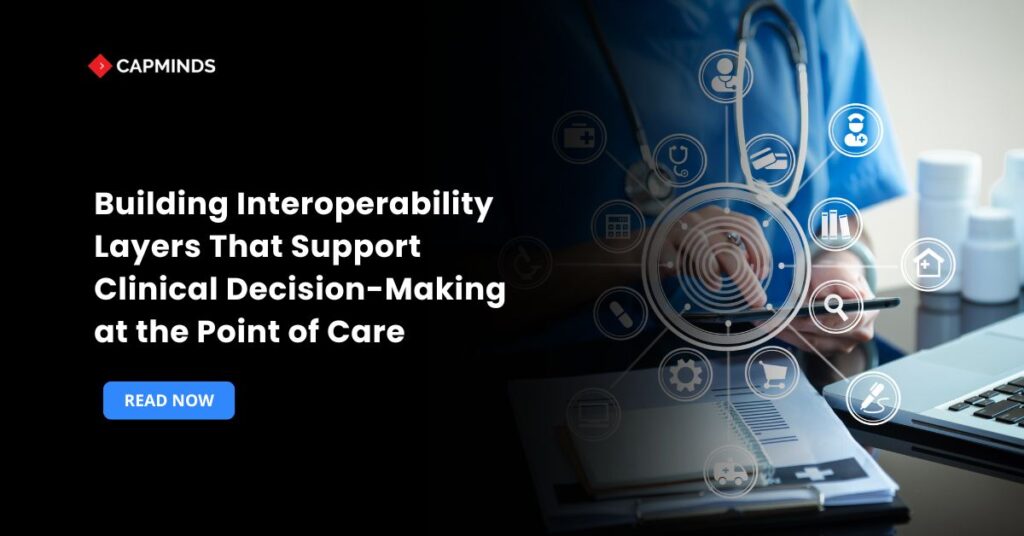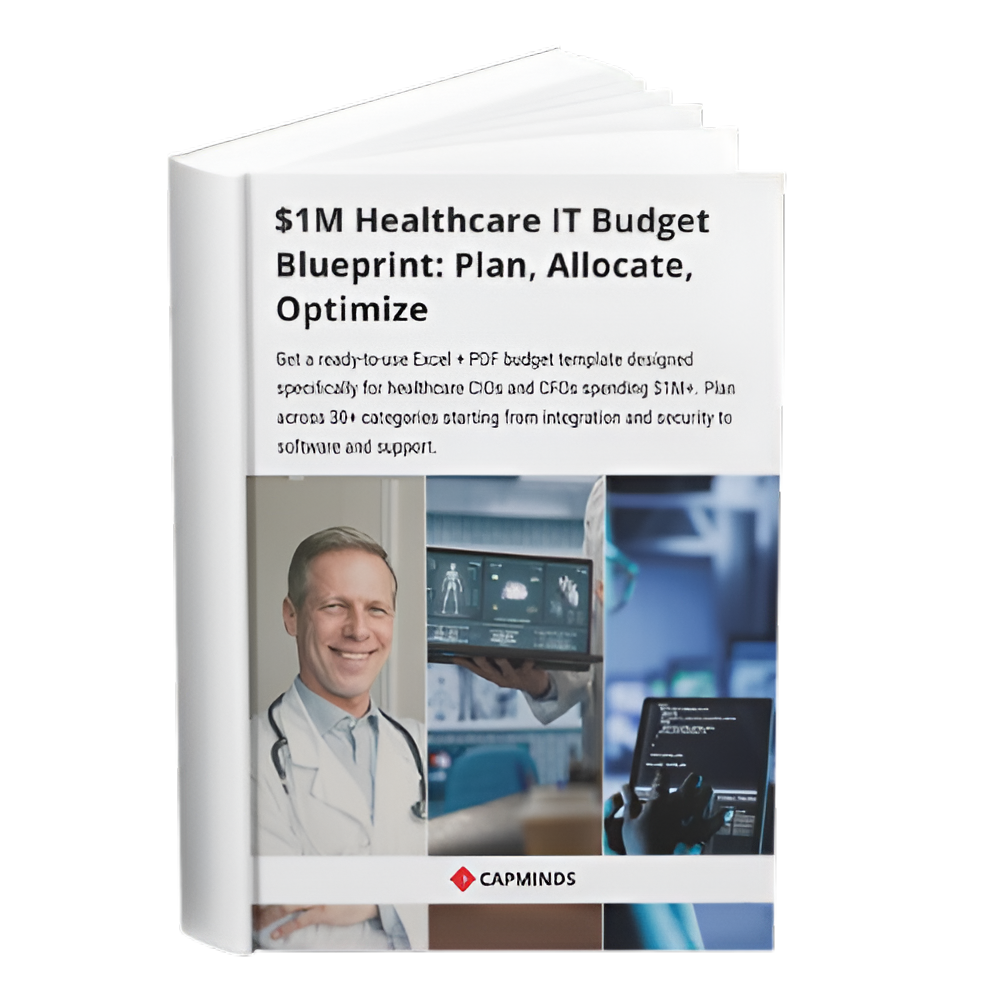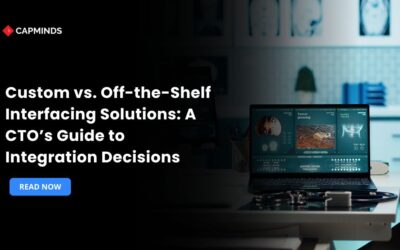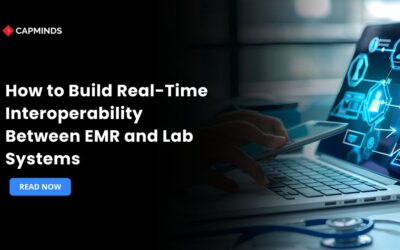Building Interoperability Layers That Support Clinical Decision-Making at the Point of Care
A medication allergy alert or a sepsis risk score reaching the doctor before an order is issued might be the difference in data-rich hospitals. Many organizations still transfer data in 30-minute batches or use brittle point-to-point interfaces.
The end effect is slow, fragmented knowledge that prevents clinical decision support from realizing its full potential. CIOs, CMIOs, and interoperability leaders are under pressure to update infrastructure so that every bedside choice is based on a comprehensive and up-to-date patient story.
In this blog, you’ll know how to design an interoperability stack that delivers the correct data to the right person at the right time.
The High Cost of Fragmented Data
A major research study demonstrated that computerized physician-order entry with CDS reduced significant drug mistakes by 55%, from 10.7 to 4.9 per 1,000 patient-days.
The hospitals using real-time workflow solutions reduced door-to-needle time by an average of 15 minutes, leading to improved neurologic outcomes.
These enhancements have common features like low latency and high-fidelity data sharing. When vitals, labs, and external records arrive immediately, CDS engines can fire precisely, and physicians can trust the suggestions.
Regulatory Tailwinds that You Can Leverage
According to the 2024 State of FHIR study, approximately 90% of health systems globally, including 98% of hospitals in the United States, currently provide FHIR-enabled APIs.
TEFCA goes live. In August 2024, the TEFCA implemented new operating procedures to connect QHINs into a “network of networks,” facilitating nationwide record retrieval.
FHIR and TEFCA work together to provide real-time access to external data sources, enabling context-aware alerts for patients outside your core network.
Structure of a Modern Healthcare Interoperability Stack
1. Data Ingestion Layer
Sources include HL7v2 ADT/ORM/ORU feeds, device telemetry, HIE query replies, and imaging.
Best Practice: Convert all inbound messages to the canonical FHIR R5 model as soon as practicable.
2. Terminology and Normalization Layers
Map local codes to LOINC, SNOMED CT, and RxNorm; offer a $translate function to prevent downstream apps from guessing at vocabulary.
3. Persistence Layer
Combine a high-availability operational FHIR store with a streaming cache like Redis to achieve sub-second reads.
4. Orchestration Layer
Use an event bus such as Kafka/NATS in conjunction with an API gateway to route, enhance, and secure traffic. Implement FHIR Subscriptions to ensure that CDS engines only get relevant updates.
5. CDS and Analytics Layer
House rules engines, artificial intelligence inference services, and prediction models. Enable CDS Hooks 2.0 for event-based invocation.
6. Delivery & UX Layer
Integrate SMART-on-FHIR applications, toast alerts, and mobile push messaging directly into EHR processes and clinicians’ cellphones.
Designing each tier as a separate, horizontally scalable service keeps a single vendor upgrade or queue backlog from impacting the whole data pipeline.
Standards & Protocols
|
Purpose |
Modern Standard |
Why It Matters |
|
Transactional messages |
HL7 v2 | The language franca for ADT and lab findings remains the same; convert, but do not destroy it. |
| REST/bulk APIs | HL7 FHIR R5 | Adds Bulk Data and Subscriptions, cornerstones of real‑time analytics. |
| Workflow integration | SMART‑on‑FHIR + OAuth 2.0 | Embeds third‑party apps securely inside EHR frames. |
| Event‑based CDS | CDS Hooks 2.0 | Allows external CDS services to inject cards like alerts, order sets at key moments. |
| Nationwide exchange | TEFCA QHIN connections | One connection => reach every other QHIN participant. |
Five Sub-Second Performance Design Principles
- End-to-end latency budget < 500 ms. Event streaming and inline caches are non-negotiable.
- To eliminate duplication and prevent alert fatigue, use idempotent event IDs.
- Auto-scaling according to queue depth and horizontal scalability using containers.
- Centralized administration of terminology to ensure that all downstream services understand it.
- Zero-trust security includes audit trails that meet TEFCA and HIPAA traceability requirements, as well as token introspection on each call.
Where to Invest in Internal Talent: Build vs. Buy
1. FHIR Gateway & Bulk API
Build: Your DevOps team has experience with OAuth and is already using Kong/Apigee.
Buy: Out of the box, you require audit logging, ONC-certified endpoints, and round-the-clock support.
2. Terminology Service
Build: You have a certified SNOMED CT mirror and uphold internal vocabularies.
Buy: You don’t have enough employees to handle weekly code-set modifications.
3. Rules / AI Models
Build: Proprietary algorithms are owned and validated by the data-science team.
Buy: You must have FDA-approved sepsis or drug-interaction guidelines right away.
These days, a lot of manufacturers provide interoperability platform-as-a-service bundles that include FHIR, event streaming, and CDS Hooks; check if these can operate in your chosen cloud and connect to TEFCA without requiring any special effort.
Roadmap for Implementation (12 Months to MVP)
- Months 0–2: Gap and Baseline Analysis – Map all incoming and outgoing feeds and measure the delay between intake and alert.
- Months 3–6: FHIR Façade Stand Up – Next to old HL7 brokers, layer an FHIR proxy; allow a sandbox CDS application to access patient, medication, and lab information.
- Months 6–9: Transition to Streaming Events – Transfer vitals and high-volume ADT channels to Kafka; activate FHIR subscriptions for condition and observation.
- Months 9–12: Incorporate CDS Hooks – Register low-risk hooks, such as prescription drugs; record override data to improve the rules.
- Year 2: Expand and Enhance – To enable countrywide TEFCA reach, containerize AI models, auto-scale workload, and move HIE traffic to a QHIN.
To keep tech development in line with patient benefit, each phase should conclude with a clinical KPI criterion, such as allergy-alert accuracy or sepsis bundle start time.
KPIs All Interoperability Leads Need to Monitor
- Target ingest-to-alert delay median < 2 s
- Duplicate alert rate target <1%
- External record match rate via TEFCA is greater than 85% of interactions
- Target > 95% is the clinician’s overriding explanation that was recorded.
- Each release has an outcome-driven measure such as sepsis bundle compliance.
Avoiding Common Mistakes
- Interfaces that are “one-and-done” should be replaced with topic-based events and canonical FHIR to prevent CDS from being broken by updates.
- Governance afterthought includes clinical governance sign-off and language in each sprint.
- Instrument the whole channel and auto-scale brokers before backlogs develop to prevent latency creep.
- Security gaps to comply with HIPAA and TEFCA regulations, enforce least-privilege scopes, and ensure ongoing token validation.
Turn Real-Time Data Into Real-Time Decisions With CapMinds
Your physicians shouldn’t wait minutes, let alone hours, for the knowledge that drives life-saving choices.
The high-velocity data mesh that transforms disparate streams into useful bedside intelligence is created by CapMinds.
From plug-and-play FHIR gateways to FDA-cleared sepsis algorithms, we link every layer of your interoperability stack with quantifiable clinical KPIs.
Why work with CapMinds as a partner?
- Interoperability Services: HL7 v2 bridges, real-time event streaming, and FHIR APIs that are TEFCA-ready.
- Clinical Decision Support: CDS Hooks cards customized for your workflows, rules engines, and predictive AI.
- EHR Integration & Optimization: Write-back documentation, single-sign-on, SMART-on-FHIR applications.
- Security and Compliance: Continuous audit trails, zero-trust architecture, and HIPAA/ONC certification.
- Managed Cloud & DevOps: Auto-scaling containers, cost-effective deployments, round-the-clock monitoring.
Get in touch with our professionals right now to develop a prototype in 90 days and see the growth in revenue metrics, sepsis bundle times, and alert accuracy.
Contact CapMinds to set up a free strategy consultation right now.




